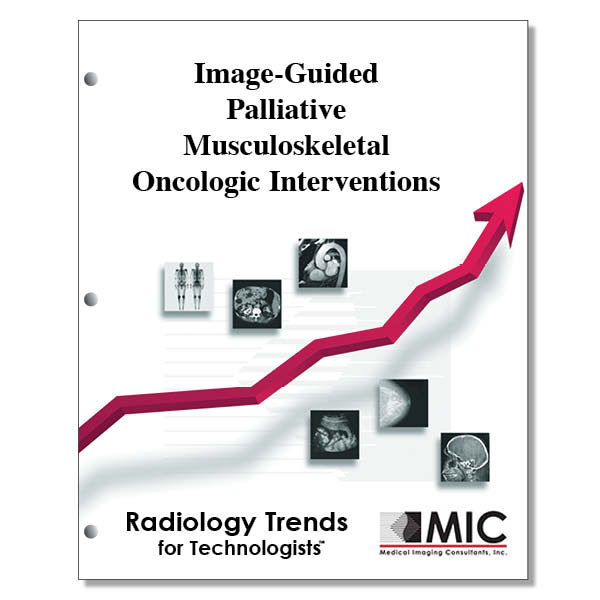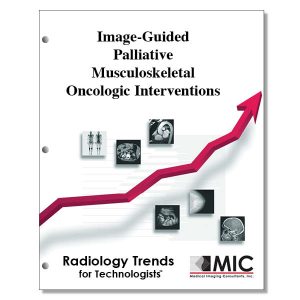

Image-Guided Palliative Musculoskeletal Oncologic Interventions
Advances in percutaneous image-guided minimally-invasive musculoskeletal oncologic interventions are reviewed as part of managing cancer in modern-era medicine.
Course ID: Q00785 Category: Radiology Trends for Technologists Modalities: CT, PET, Radiation Therapy, Radiography, RRA, Vascular Interventional2.5 |
Satisfaction Guarantee |
$29.00
- Targeted CE
- Outline
- Objectives
Targeted CE per ARRT’s Discipline, Category, and Subcategory classification:
[Note: Discipline-specific Targeted CE credits may be less than the total Category A credits approved for this course.]
Computed Tomography: 0.75
Procedures: 0.75
Head, Spine, and Musculoskeletal: 0.50
Neck and Chest: 0.25
Magnetic Resonance Imaging: 0.50
Procedures: 0.50
Neurological: 0.25
Musculoskeletal: 0.25
Nuclear Medicine Technology: 0.25
Procedures: 0.25
Endocrine and Oncology Procedures: 0.25
Registered Radiologist Assistant: 2.50
Procedures: 2.50
Musculoskeletal and Endocrine Sections: 1.50
Neurological, Vascular, and Lymphatic Sections: 1.00
Vascular-Interventional Radiography: 2.50
Procedures: 2.50
Vascular Interventional Procedures: 0.50
Nonvascular Procedures: 2.00
Outline
- Introduction
- Bone Thermal Ablation
- Soft-Tissue Thermal Ablation
Objectives
Upon completion of this course, students will:
- identify the rank of cancer as a cause of death in the U.S.
- be familiar with the advances in percutaneous image-guided minimally invasive musculoskeletal interventions for cancer management
- be familiar with the percentage of patients with osseous metastatic disease who experience SREs
- identify the primary limitations of surgical interventions for patients with bone metastases
- recognize the limitation for opioids in managing cancer-related bone pain
- be familiar with the primary consideration supporting the incorporation of percutaneous thermal ablation into treatment guidelines for bone metastases
- be familiar with the patient indicator for percutaneous thermal ablation for managing bone metastases
- be familiar with the effectiveness of radiofrequency ablation for treating painful bone metastases
- be familiar with the pain palliation when using RFA for bone metastases
- identify the complication rate reported by Deib et al when using microwave ablation for extraspinal bone metastases
- be familiar with the finding of the CAFÉ trial regarding VA
- be familiar with the main benefit of VA in terms of pain relief and fracture reduction
- identify the contraindication for percutaneous thermal ablation
- be familiar with the use of thermal ablation as an alternative plan for managing spinal metastases
- be familiar with the range of statistically significant pain palliation observed in percutaneous ablation and VA
- identify when musculoskeletal soft-tissue tumors are considered for thermal ablation
- be familiar with the ice ball extension while performing cryoablation
- understand the treatment criteria for patient receiving cryoablation
- be familiar with the major complications with cryoablation for desmoid tumors
- be familiar with a limitation in managing transfixing pathologic fractures
- identify the anatomical areas where osteosynthesis or percutaneous fixation is performed
- be familiar with technical advancements that have contributed to the recent expansion of percutaneous FICs application
- be familiar with observed opioid use at 6 weeks post-procedure per Roux et al.’s study
- be familiar technique that broadened the spectrum of available nerve targets for deployment of establish agents
- be familiar with the success of percutaneous image-guided splanchnic nerve cryoneurolysis for palliation of intractable pain in patients with pancreatic cancer
- be familiar with the use of implanted drug delivery systems used in pain management
- be familiar with the routes of palliative pain injections in cancer patients
- be familiar with the indications for perineural injections
- identify specific cancer surgeries where perineural injections have been suggested to reduce postsurgical pain
- identify the musculoskeletal metastases that are treated with preoperative embolization
- identify the embolic agent use for selective embolization of bone metastases
